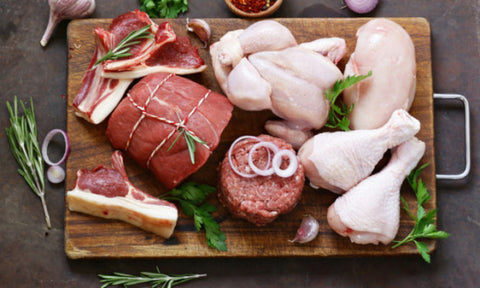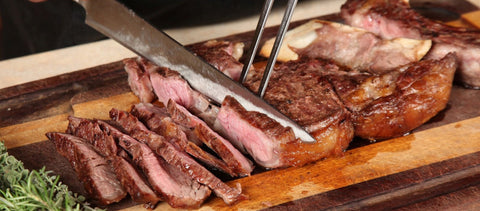However we do it, red meat is a food full of beneficial nutrients and plays a very important role in the context of a healthy and balanced diet. But let's not forget that it should be consumed in moderation!
Beef, sheep and pork are classified as red meat, although some parts of which under certain conditions can be classified as white meat. In general, pork is the leanest, lamb the fattiest and veal the most nutritious meat. This is a family of foods rich in characteristics that contribute to proper development for people of a young age and which should be gradually reduced at older ages.
Proteins
Red meat is an important source of protein, essential for healthy muscles, bones, organs and blood circulation. The proteins found in meat are considered complete, meaning they contain all the amino acids (leucine, isoleucine, methionine, lysine, phenylalanine, threonine, tryptophan) that the body cannot create on its own. It is important for the strengthening and renewal of the body, it plays a fundamental role in cellular maintenance as well as in the general health and functioning of the human body.
Iron
In general, red meat is one of the richest sources of iron, a component necessary for many functions of our body. Iron is essential for cellular respiration and metabolism, nerve development, red blood cell formation, wound healing, and even DNA synthesis. It is even recommended to increase the absorption of iron to be taken together with vitamin C, which translates into plenty of vegetables with our meal and plenty of fruit during the day. Also characteristic of the quality of iron in red meat is the fact that it is easier for the body to use than iron found in plant sources.
Zinc
Red meat is also rich in easily absorbable zinc. A mineral particularly important for healthy skin and a healthy immune system. Especially this time of year and during the winter months, adequate zinc intake can help prevent colds and other infections while shielding the body. So red meat is a rich source of zinc for the body.
Beware of fats!
Like proteins and carbohydrates, fat is also necessary in our diet, to fill us with energy or even with extra pounds when we take it in excessive amounts. Fat is made up of saturated and unsaturated fatty acids. Saturated fatty acids are usually solid at room temperature and generally come from animal sources, mainly red meat. High levels of saturated fat in the diet can raise blood cholesterol levels and thus increase the risk of heart disease.
Research by veterinarians and animal technicians has been able to significantly reduce the fat content of lean red meat by changing rearing methods. So if with the help of the butcher we remove all the visible fat from a piece of meat, lean beef will contain about 5% intramuscular fat, lean pork 4% and lean lamb 8%.
Beef & veal
Beef or beef is the meat that comes from a calf aged 1 year or older. When it is less than 12 months old it is classified as a milk calf.
Beef contains 2.7mg of iron per 100g and 4.1mg of zinc. A lean grilled steak has 6g. of fat per 100g, of which 2.5g. it is saturated while the exact same piece in the pan will generously offer us 13g. of fat, of which 5g. they are saturated.
Pork
Today pigs have much less fat, which is around the muscles and therefore easy to remove. We can with a good knife remove a very large percentage of the fat in pork, which is impossible to do in beef, where the fat is filtered into the muscle tissue. Lean pork is now considered an alternative white. It is a source of vitamins A, B, D, E and K. It contains iron, phosphorus and calcium. It contains many amino acids. It has low levels of cholesterol. Its nutrients are absorbed by the body by 80%.
Sheep and goat
Lamb contains about 210 calories/100g. with its proteins being of high biological value. It has all the essential amino acids, vitamins B3, B6 and B12 as well as high concentrations of selenium and zinc.
Goat has fewer calories, about 110 per 100g, contains less fat and only 10% of it is saturated. Its cholesterol reaches 75μg, it contains the same vitamins and nutrients, but it contains larger amounts of sodium and potassium than lamb.
Organic meat
Following the trend of recent years, animal husbandry has brought organic meat to supermarket windows and butchers' fridges. With a slightly higher price like all organic products, an impact of their healthy lives and the equally expensive and organic foods they feed them to reach the required weight, organic livestock follows some rules that are controlled by certified organizations. Thus, according to the strict conditions of DIO, in order for pigs, calves or lambs to be classified as organic farming:
Animals must be fed organic feed
The feeding of the animals must be based on the maximum possible use of pasture depending on the available pastures in the different periods of the year.
At least 60% of the dry matter of the daily feed must be coarsely ground, fresh, dried or ensiled forage.
Newborns should be fed natural milk for at least 45 days
Only very specific drugs are allowed to be used to combat diseases and under the strict supervision of a veterinarian.
In general, the truth is that it is difficult to buy from some random butcher, guaranteed organic meat. Organic products are always accompanied by special DIO certification stamps, as well as special stamps certifying the Greek or foreign origin of the animal as well as the place of slaughter.




Comments (0)
There are no comments for this article. Be the first one to leave a message!